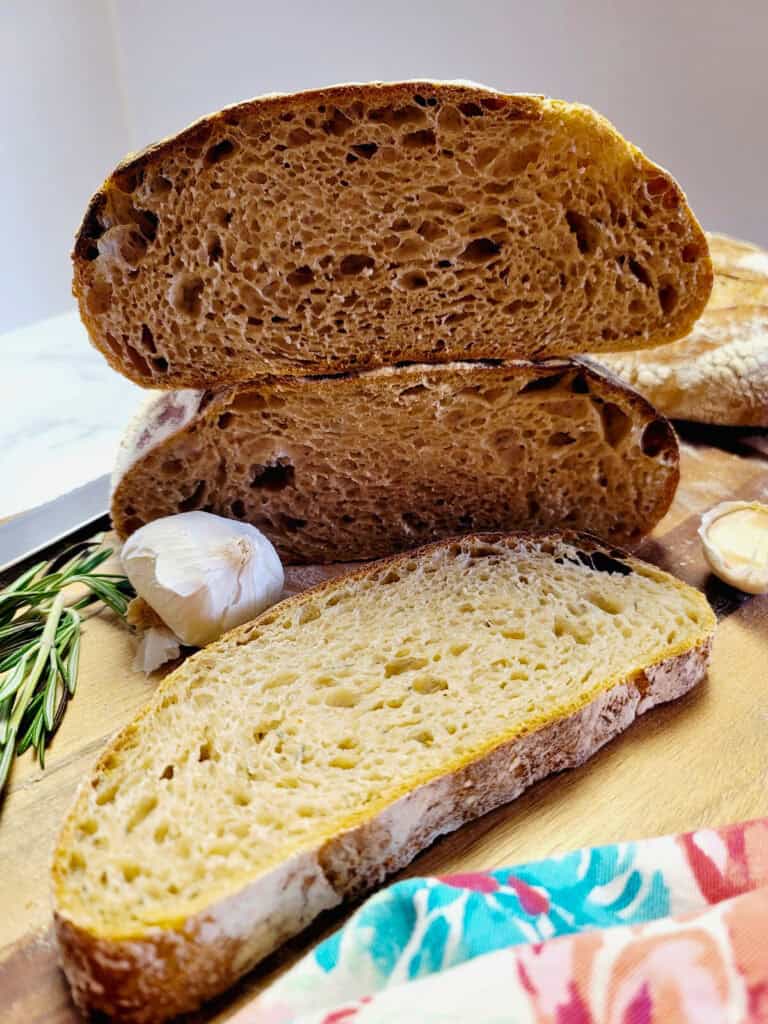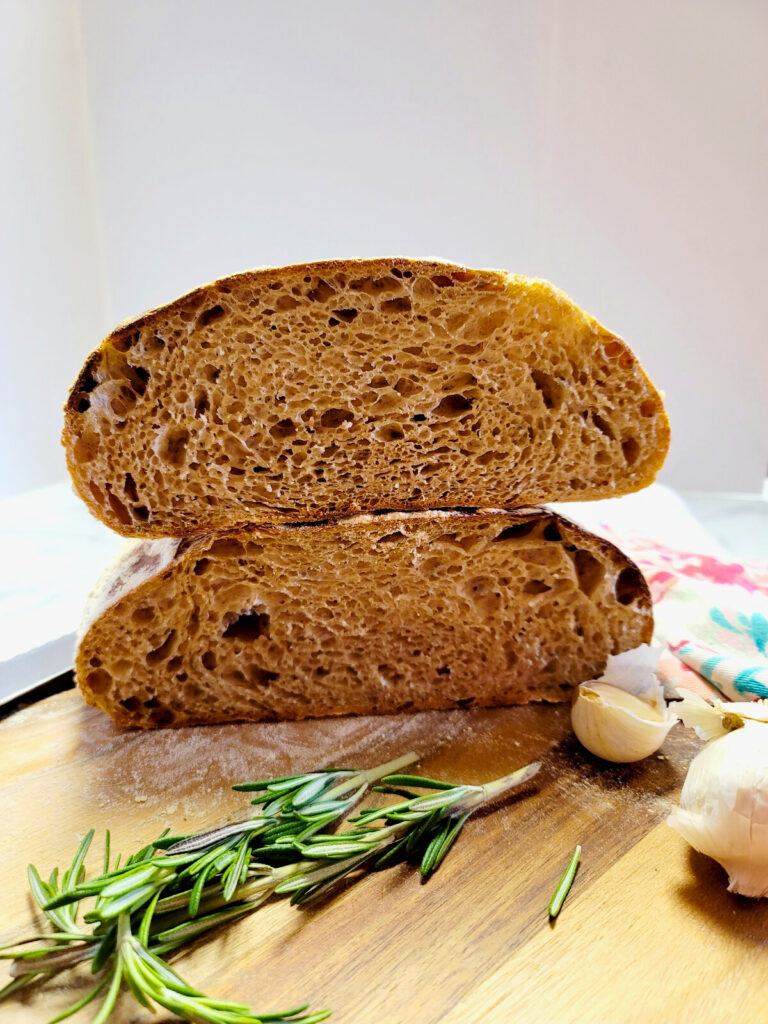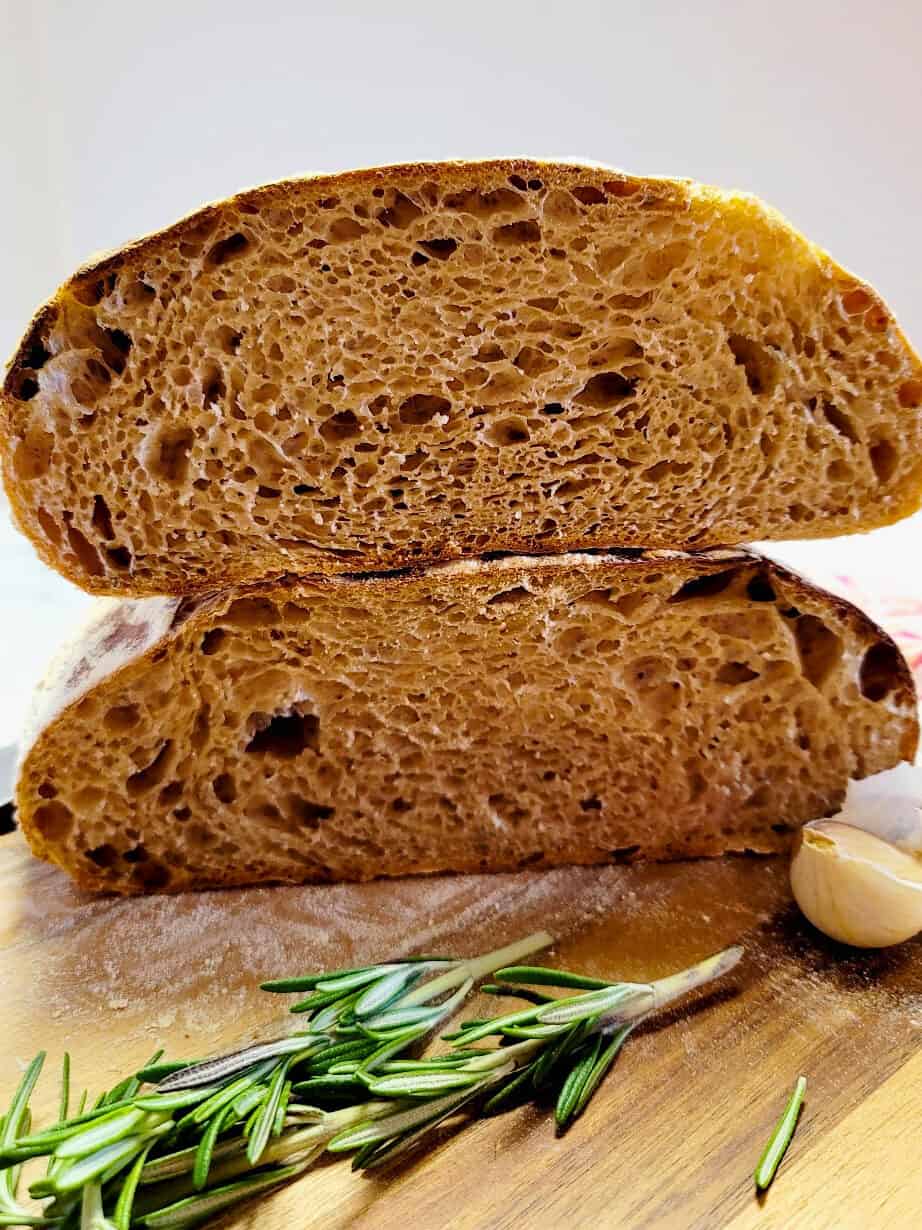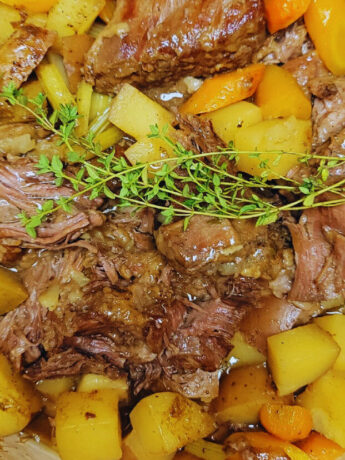The bold flavor of this Roasted Garlic and Rosemary Sourdough Bread is out of this world. It pairs well with a hearty stew rich pasta dish like this Homemade Lasagna.

If you have gained confidence in making Sourdough Bread, you are probably ready to start diving into making “all things” sourdough. Simply flavoring sourdough is one of the easiest ways to start that journey.
Simply added roasted garlic and minced fresh rosemary is a great way to change up your sourdough loaf when you are wanting to serve it alongside a main course.
Get that starter fed and read on….. Happy Baking!!
More Bread Recipes
Ingredients Needed
- Fed Sourdough Starter
- Flours – A mixture of bread flour and all-purpose flour.
- Water – Filtered water is recommended anytime you are making sourdough bread.
- Salt
- Roasted Garlic – 1 whole head of roasted garlic provides this bread with loads of garlic flavor.
- Fresh Rosemary – I have not tested this recipe with dried rosemary, but I am sure you can get great flavor from it if that is what you have. You may have to use a lot of dried rosemary to achieve a strong rosemary flavor.

How to Roast Garlic
- Preheat oven to 400 °F. In a small oven safe pan place a piece of foil large enough to wrap the garlic.
- Cut the top of the garlic off just enough to expose the cloves. Place it in the foil and pour over the oil. Close the foil and place the pan into the oven.
- Roast for 40 minutes and check the garlic. You can use a pair of tongs to gently squeeze the head of garlic. You are looking for the garlic to be soft and browned.
- Take out of the oven and let cool before using.
How to Make Roasted Garlic and Rosemary Sourdough Bread
For this recipe I follow my basic Sourdough Bread recipe. The only exception is that I add in the roasted garlic and rosemary when I add in the salt and starter. By doing this the garlic and rosemary are mixed in when the dough is “kneaded”. For a more in dept recipe on how to make Sourdough Bread and the full kneading process (slap and fold) see my recipe.
Feed Starter – As early as possible so that you have time for the whole process.
Autolyse – Mix flour and water and set aside to autolyse for 1 hour.
Note* If you store your starter in the fridge in between baking I recommend pulling it out the night before and feeding it to give it a jump start for the morning.
Add Remaining Ingredients – Add the active starter, salt, (mashed) roasted garlic and minced fresh rosemary.
Knead Dough – This is typically done with a “slap and fold” technique. See my Sourdough Bread recipe if you are not familiar with this technique. I often do this in a gentler form right in the bowl that my dough is in.

Stretch and Fold – After kneading the dough, cover it with a damp cloth and let it rest in a warm area for 30 minutes. After 30 minutes, stretch and fold the dough. Cover and let it rest for 15 minutes. Stretch and fold and repeat two more times, then rest it 3 more times at 30 minutes intervals. Stretching and folding in between rests.
Bulk Ferment – After the last stretch and fold cover the dough with a damp cloth and place in a warm place to bulk ferment. This will take several hours. To speed up the bulk fermentation process you can us your stove light or even place the dough in the oven with the light on and turn the oven on for a few seconds periodically as it is sitting to gently warm the oven.
Shape and Refrigerate – Shape and place in your dough in a floured banneton or bowl. Or you can line a bowl with parchment paper for easier pick up if you want to transfer the dough straight from the bowl to the dutch oven. When doing this method place the dough seam side down on the parchment. Cover with a plastic bag and refrigerate overnight. Aim for 12-24 hours.
Bake Bread – 1 hour before baking preheat your cast iron dutch oven. When ready lightly flour the cast iron, invert the dough onto the hot cast iron and score. Cover the dough and place in the oven for 20 minutes. After 20 minutes reduce the heat to 450° F and remove the top cast iron pan. Bake for another 20 minutes. Cool completely before slicing. Enjoy!

Note* If you are using parchment paper for easier removal do not flour the cast iron. Score the dough first then gently pull the dough (using the parchment paper) out of the bowl and place in the dutch oven.
How long does Sourdough Bread last?
I have found that Sourdough Bread lasts about 5 days when properly wrapped and stored. It is best when consumed the first day but can be warmed or toasted when eating it later.
The best storage is to simply wrap it with a cloth such as a tea towel. Store it in a cool dark place or freeze.

Is Sourdough Bread really good for you?
The fermentation process that Sourdough Bread goes through makes it easier for you to digest than most breads. Sourdough Bread also has beneficial bacteria that feed the “good” bacteria in your intestines. Think of it like a probiotic!
Handpicked Recipes







Tried This Recipe?
Leave a review below, I would love to hear how it turned out! ⭐⭐⭐⭐⭐
Follow Simply Scratch Made on Pinterest.
Roasted Garlic and Rosemary Sourdough Bread
The bold flavor of this Roasted Garlic and Rosemary Sourdough Bread is out of this world. Pair it with a rich beef stew or a tomato-based pasta dish like lasagna.


Ingredients
Instructions
-
About 1 hour before you think your starter will be ready to use combine the warm water and both flours in a large bowl. Cover with a damp cloth and allow to sit for 1 hour.
-
After 1 hour add the mashed garlic, minced rosemary, 90-100 grams of active starter and 10 grams of salt to the dough. Begin kneading the dough using the slap and fold technique. Do this for about 5 minutes or until the dough begins to come together. Cover the dough with a damp cloth and let it rest in a warm place for 30 minutes.
-
After 30 minutes, stretch and fold the dough. Cover and let it rest for 15 minutes. Stretch and fold again, let it rest for 15 more minutes, repeat this process one more time. A total of 3 15-minute intervals.
-
Now stretch and fold the dough, cover and rest for 30 minutes. Repeat this process two more times for a total of 3 30-minute intervals.
-
Cover the dough and let it bulk ferment for several hours. The dough will be ready to shape after it has doubled in size. This can take anywhere from 5-8 hours, depending on the temperature. Even longer if bulk fermenting in a cold spot.
-
Shape and place in your dough in a floured banneton or bowl. Or you can line a bowl with parchment paper for easier pick up if you want to transfer the dough straight from the bowl to the dutch oven. When doing this method place the dough seam side down on the parchment. Cover with a plastic bag and refrigerate overnight. Aim for 12-24 hours.
-
1 hour before baking preheat your cast iron dutch oven. When ready lightly flour the cast iron, invert the dough onto the hot cast iron and score. Cover the dough and place in the oven for 20 minutes. After 20 minutes reduce the heat to 450° F and remove the top cast iron pan. Bake for another 20 minutes. Cool completely before slicing. Enjoy!




This is the most delicious, moist bread I’ve had in a long time. Thank you for this yummy recipe! Can’t wait to make it again!
Thank you!
This looks amazing. I didn’t expect the combination of roasted garlic and Rosemary will make the bread delicious. Definitely going to give it a try.
Thank you!
Thanks for the recipe – we love roasted garlic in our bread, but typically make garlic and olive sourdough! This was a nice change, and it worked brilliantly!
Garlic and olive sourdough sounds delicious! I am so glad to hear you like the roasted and rosemary bread.
The flavors are perfectly balanced, with just the right amount of garlic and rosemary. The crust is perfectly crispy, and the inside is wonderfully chewy. It’s a definite must-try!
Thank you for your wonderful comment!
This was such a quick and easy recipe that does not disappoint! Turned out light, fluffy and delicious; easily, a new favorite recipe!
That’s great to hear, thank you!